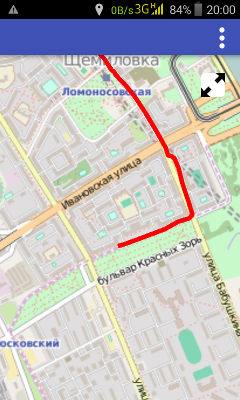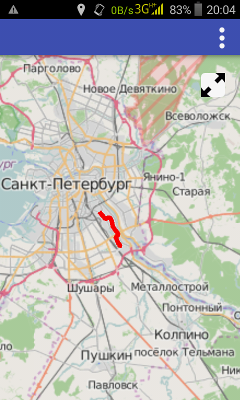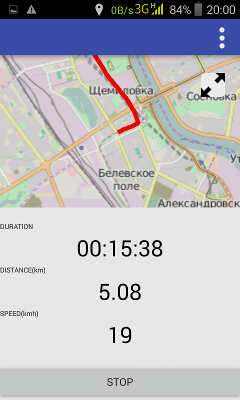GPS tracker on Qt, map and track
I decided to practice programming for Android on Qt. I chose a GPS tracker as a topic.
The set of functions of this tracker:
- take measurements from the GPS receiver;
- export track to GPX ( GPS eXchange Format );
- display the track on the map;
- display travel time, path length, average speed.
Under the cut will be an example of working with a map in QtQuick.
Plugin, PluginParameter and Map
The basic types are in the Qt Location module. Qt Location as a backend can use:
Work with a specific map provider is placed in plugins ( Plugin ), which are configured through parameters ( PluginParameter ).
Minimal example:
Plugin {
id: plugin
preferred: ["here", "osm"]
required: Plugin.AnyMappingFeatures | Plugin.AnyGeocodingFeatures
}
Map {
plugin: plugin
width: ...
height:...
}At first, I just used the Open Street Map:
Plugin {
id: plugin
name: "osm"
}
The default provider of OSM maps is MapQuest , which has recently introduced a developer key. Then the question arose of switching to something else.
Open street map plugin
The documentation lists support for:
- MapQuest
- ThunderForest ;
- OpenStreetMap and community.
In order to use the last item, you must fulfill two conditions:
Set the osm.mapping.host parameter :
Plugin {
id: mapPlugin
name: "osm"
PluginParameter {
name: "osm.mapping.host";
value: "http://a.tile.openstreetmap.org/"
}
}Map the map to use MapType.CustomMap map type .
For lovers of magic:
Map {
id: map
plugin: mapPlugin
activeMapType: map.supportedMapTypes[7]
}In order not to rely on the position of an element in the supportedMapTypes list , you can do this:
Map {
id: map
plugin: mapPlugin
zoomLevel: 16
width: item.width
height:item.height
property MapPolyline track
}
Timer {
interval: 100; running: true; repeat: false
onTriggered: {
for(var i = 0;
i < map.supportedMapTypes.length;
++i){
if(map.supportedMapTypes[i].style
=== MapType.CustomMap){
map.activeMapType = map.supportedMapTypes[i];
}
}
}
}Track
To draw a track, I took the MapPolyline element , while creating it dynamically, to clear the map:
function start() {
mapItem.clearMapItems();
mapItem.track = Qt.createQmlObject('import QtLocation 5.6; MapPolyline {}', item);
mapItem.track.line.width = 6;
mapItem.track.line.color = 'red';
mapItem.addMapItem(mapItem.track);
}
function appendCoordinate(position){
mapItem.center = position;
mapItem.track.addCoordinate(position)
}
Map {
id: mapItem
plugin: mapPlugin
zoomLevel: 16
width: item.width
height:item.height
property MapPolyline track
}At start, I clear the map, create a track and place it on the map. When adding a new coordinate, the center of the map moves to the specified position and the track lengthens.
Result:



Code Available on GitHub
